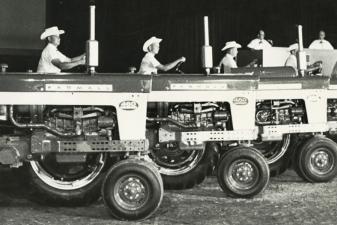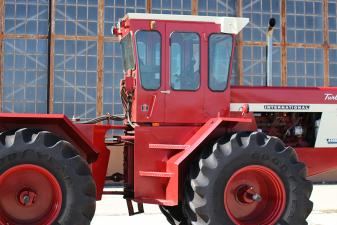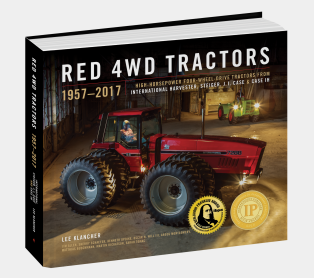The 4994's Curse
An Excerpt from Red 4WD Tractors

Despite positive customer satisfaction reviews, the 4994 (and its sales representatives) couldn’t overcome the bad reputation held by V-8 engines at the time. Ultimately, the engine’s reputation would precede the tractor, resulting in limited sales success throughout the model’s short run. Read more about the 4994 and its place within the 94 Series lineup in this excerpt from Red 4WD Tractors 1957–2017.
[Above image caption: This 4994 wears very early Case IH labeling on the hood. Note that “International” is spelled out and in front of CASE. These machines were J.I. Case legacy tractors rebadged after the Case IH merger in 1985. Case IH]
The 94 Series was the final complete evolution of the J. I. Case four-wheel-drive line. It pretty much followed the 90 Series in scope but added a new contender into the mega-tractor market, the 4994. The most noticeable change was a complete turnover to a black-and-white color scheme. This has less to do with cosmetics than it did with new painting regulations from the EPA that added increased expense to the application of certain types and colors of paint, red among them.
The 94 Series went digital when the intelligence center replaced the standard analog instrument panel. The intelligence center offered electronic readouts for fuel, coolant temp, EGT (exhaust gas temperature), and volts, but a multifunction digital readout could switch from rpm, ground speed, wheelslip, acres covered, etc. These features are commonplace today, but in 1984, it was cutting edge. The Silent Guardian cab debuted in the 94 line, claiming to reduce sound levels and it definitely added visibility. The accommodations and control layout were improved to make the cab a nicer place to work those long hours. The differential lock was made electronic with rocker switch activation.
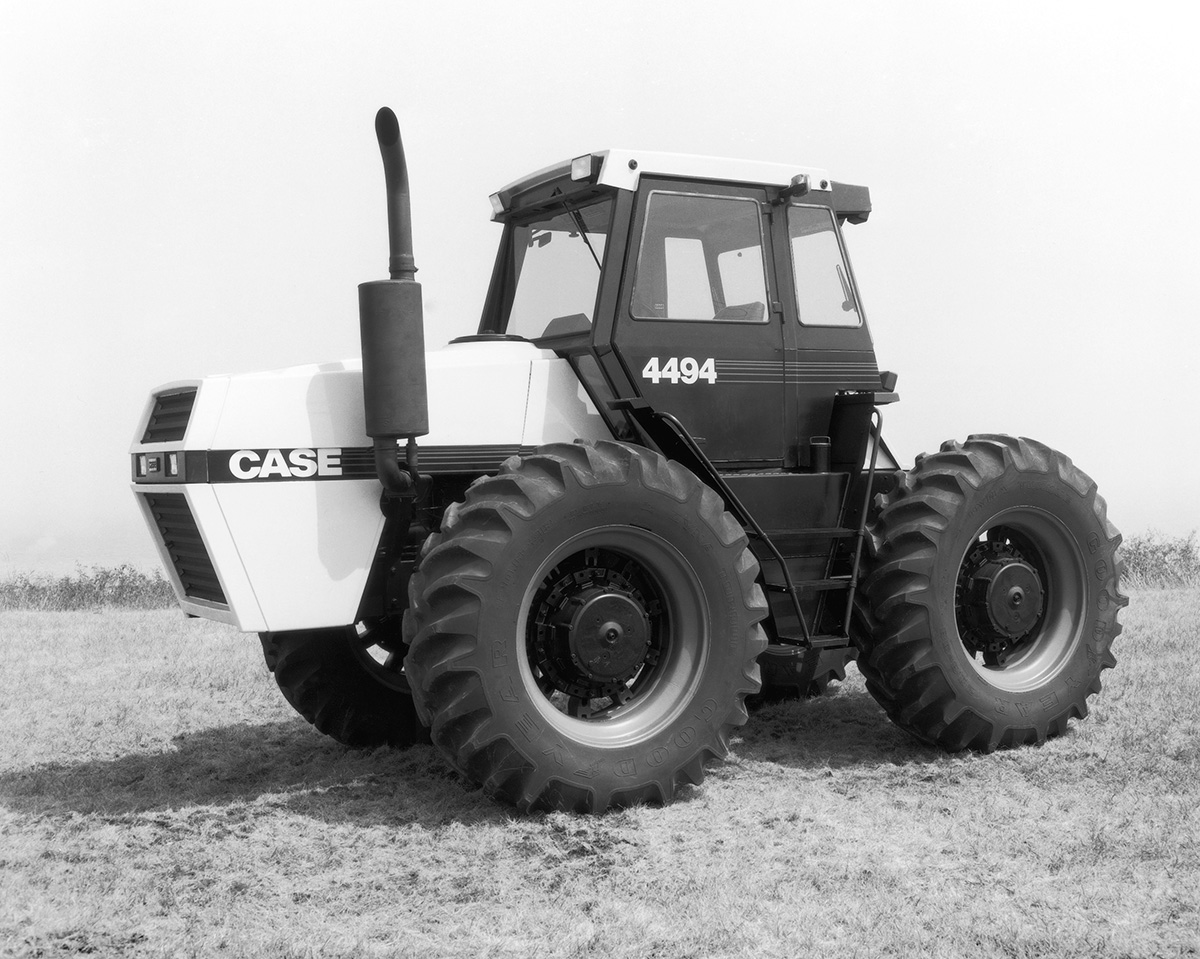 Case 4494
Case 4494
The 94 Series got some styling changes that include a new black-and-white paint scheme. The 175–PTO horsepower 4494 was no longer the base four-wheel drive, with one model now below it. The 4494 sat on a 102-inch wheelbase and had a maximum ballasted weight of 22,500 pounds. A Cat III hitch was a $6,300 option, and a 1,000-rpm PTO would set you back $3,300. Case IH
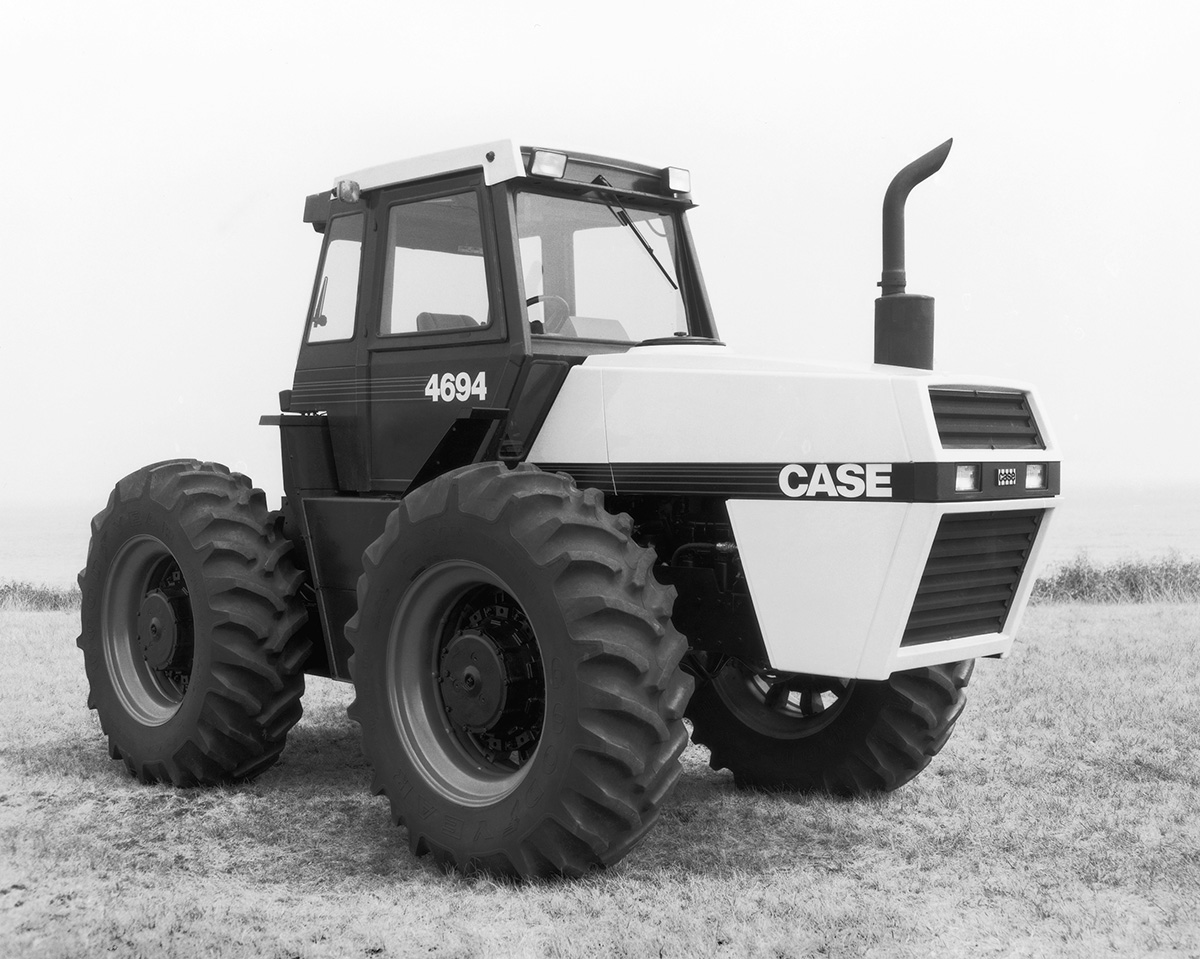 Case 4694
Case 4694
The 4694 was now the middle of a five-tractor lineup and still largely an uprated 4494. The uprate came mainly from the turbo-intercooled 504, which was run at its highest factory rating, 219 PTO horsepower. The black-and-white photo is appropriate in this era because the color scheme had changed to black and white. Case IH
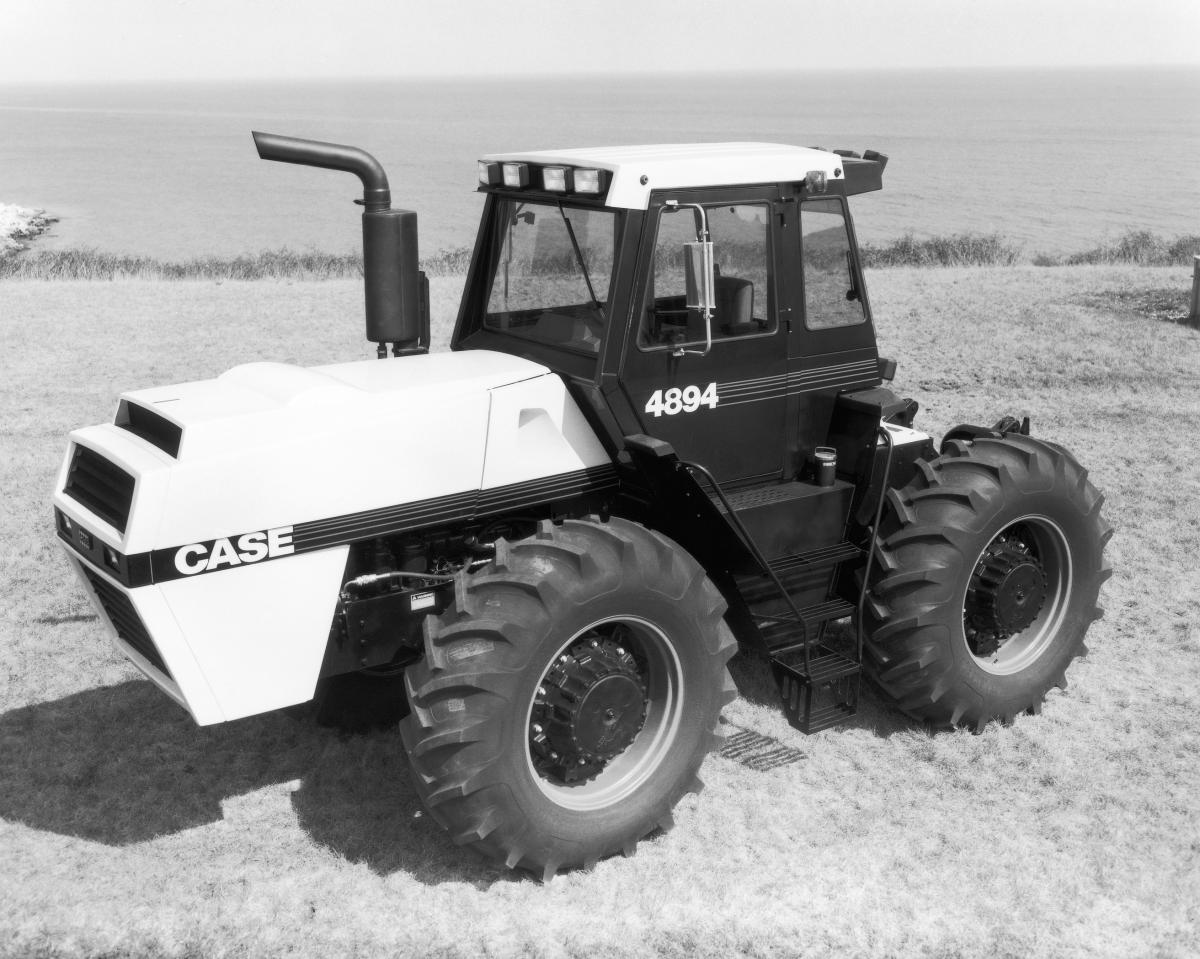 Case 4894—Top Dog No More
Case 4894—Top Dog No More
Still wearing a Power Bulge, the 4894 lost its Top-Dog status in the 94 Series lineup. The powertrain was little changed from the 90 Series. The 300-horsepower DS-11 Scania six had the same bore and stroke of the DS14 V8 and shared some components. The 4894 sat on a 110-inch wheelbase and had a maximum ballasted weight of 28,500 pounds. With dual 20.8-34 tires, it could generate 213.68 drawbar horsepower and 27,627 pounds of pull—almost equal to its ballasted weight. Case IH
For a brief time in the mid-1980s, J. I. Case lived on the top tier with the biggest and most powerful four-wheel-drive tractors on the market. Mounting an 866 cubic-inch Scania V-8 turbo diesel that made 400 horsepower on the flywheel, the 4994 was Nebraska-rated at 344 PTO horsepower and 306 horsepower at the drawbar. The big V-8 was mounted in front of a 12-speed Twin-Disc Power Shift transmission, a very heavy-duty gearbox used by other tractor manufacturers at the time, including Steiger. The 4994’s rigid-frame, four-wheel-steer configuration gave it a few niche markets articulated tractors couldn’t claim, namely areas with hilly ground where the crab steer feature made it invincible.
The 4994 was a good tractor, especially for those who needed its particular skill set, but timing worked against it. It was an expensive tractor introduced in a very down market, but it also had a sales Achilles heel. The V-8 diesel was almost universally reviled in the farming world. This had less to do with the cylinder configuration than the reputation V-8s had acquired via past tractors of other makes. Less-than-robust V-8 engines had been chosen by ill-advised ag engineers in the past and had resulted in early failures for most of them. The V-8s also tended to have a power band higher in the rpm range than inlines and generally delivered less fuel economy.
The Scania did not share these negatives. It was bulletproof and defied some of the V-8 performance and fuel economy norms. No doubt Case’s sales people thought they could market past the V-8 reputation, but that proved only partly true. Few owners had cause to regret their choice, but the V-8 did prevent some sales. A mere 224 were built, all before the formation of Case IH, and they sold slowly. The leftovers were still being sold almost to the time Steiger joined the Case IH family.
The J.I. Case 94 series tractors would be badged as Case IH machines and painted red after the 1985 merger. This series of machines displaced the International Harvester Super 70 Series and Steiger-built four-wheel-drive tractors. For a short time, the 94 series were the largest of the Case IH line of high-horsepower four-wheel-drive tractors. In 1986, Case IH purchased Steiger, and the 94 series was sold off and discontinued.
 Case 4994
Case 4994
The Scania V-8-powered 4994 was the highest power tractor J. I. Case had ever built, and it was near the top of tractor horsepower rankings. The tractor sat on a 124.8-inch wheelbase and weighed 26,500 pounds bare. It was rated for a ballasted weight up to 40,000 pounds, with 65 percent of the added weight on the front. Dual 20.8-42 tires were an option, but Erick Jacobson’s is set up for triples of that size. A rear three-point hitch was not available but a 1,000-rpm PTO cost a mere $3,700. Kyla Burnside
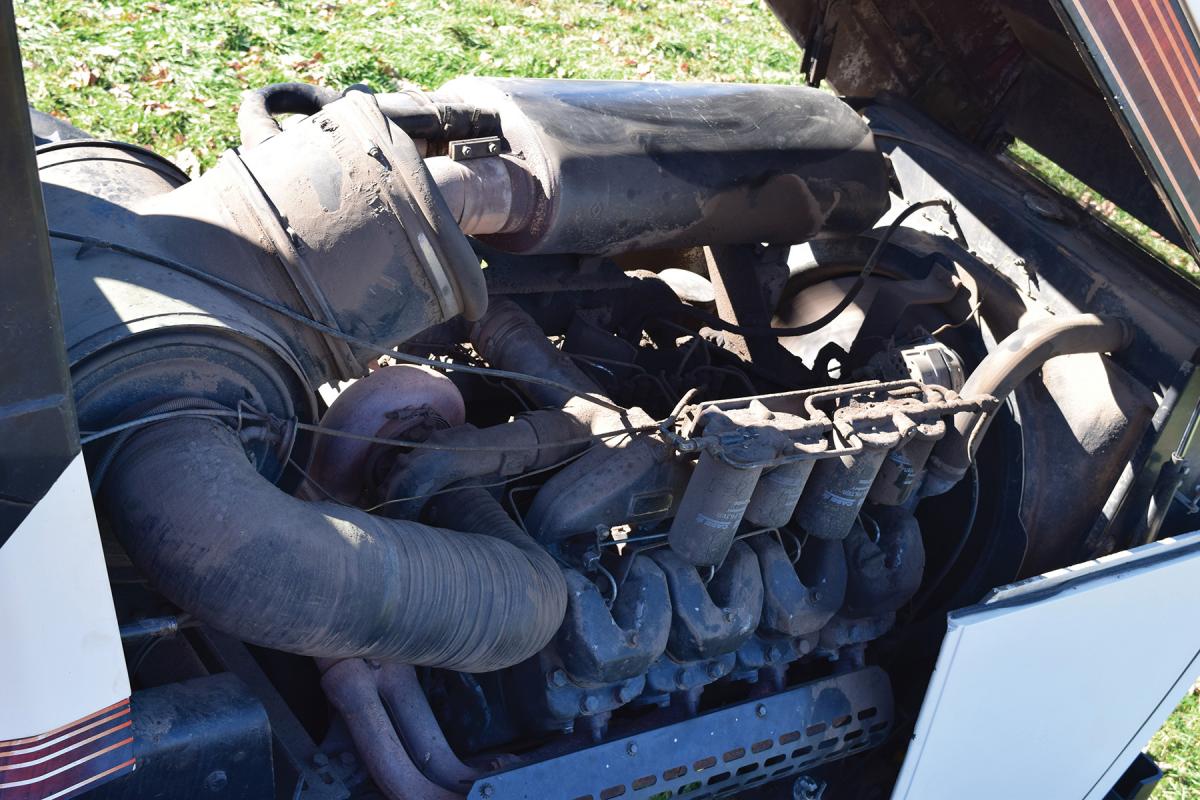
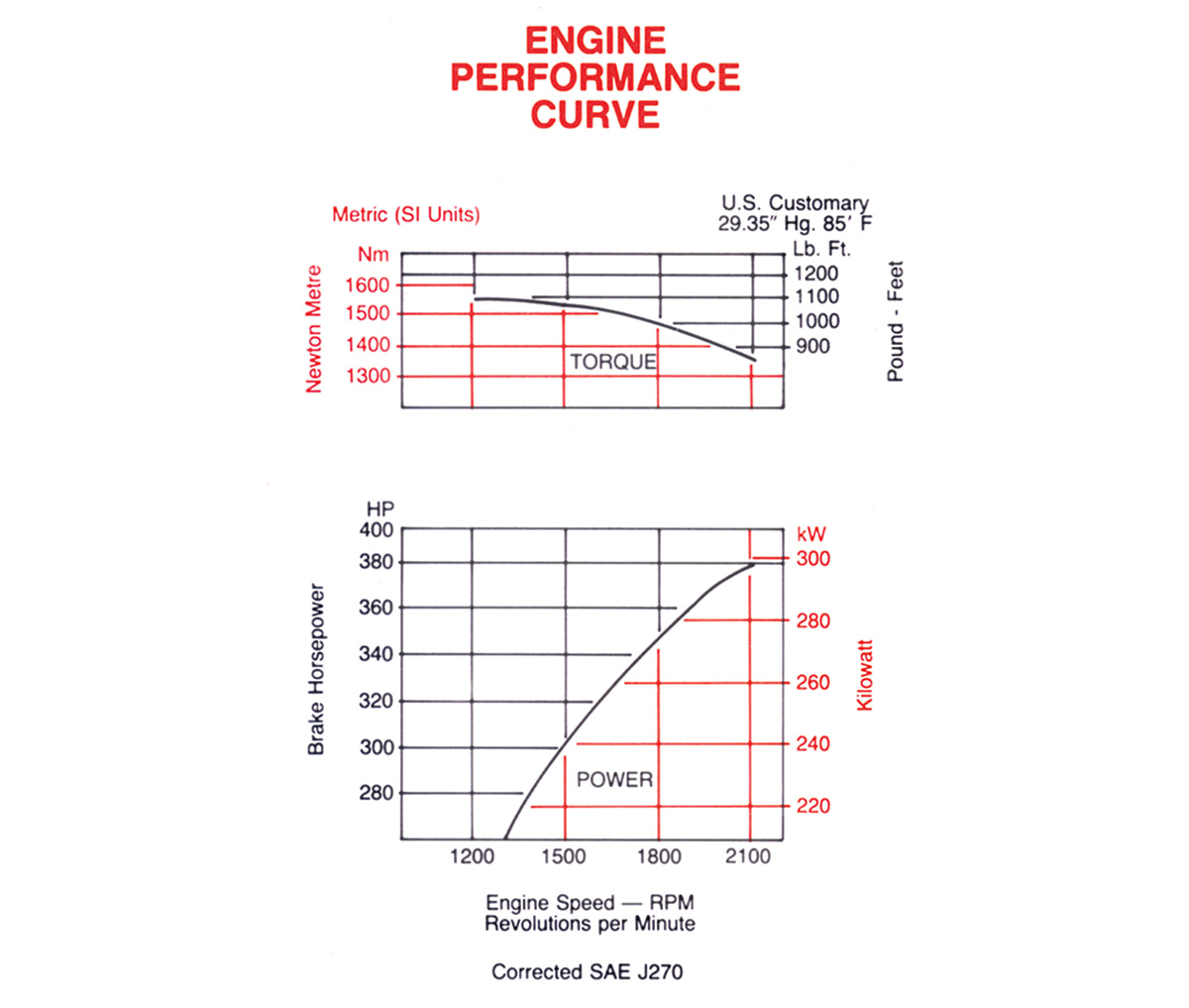 High Power
High Power
By any standard, now and especially then, the 866-cubic-inch Scania DS14 V-8 was a powerhouse. Displacing 866 cubic inches from a 5x5.51-inch bore and stroke, the wet-sleeved, direct-injected engine had some very unique design features that included individual heads for each cylinder and a centrifugal oil filter. Torque was 1,165 lb-ft at 1,300 rpm, but it held 996 lb-ft at the 2,100 rpm redline, giving it a long and broad torque band. Case rated flywheel power at 400, but that was the SAE gross rating; SAE net power was 382 horsepower. The DS14 was detuned for tractors, but in European trucks, it made up to 500 and later 565 horsepower. The Australians had a 610-horsepower DS14 before the engine got a major design upgrade in the 1990s. Kyla Burnside
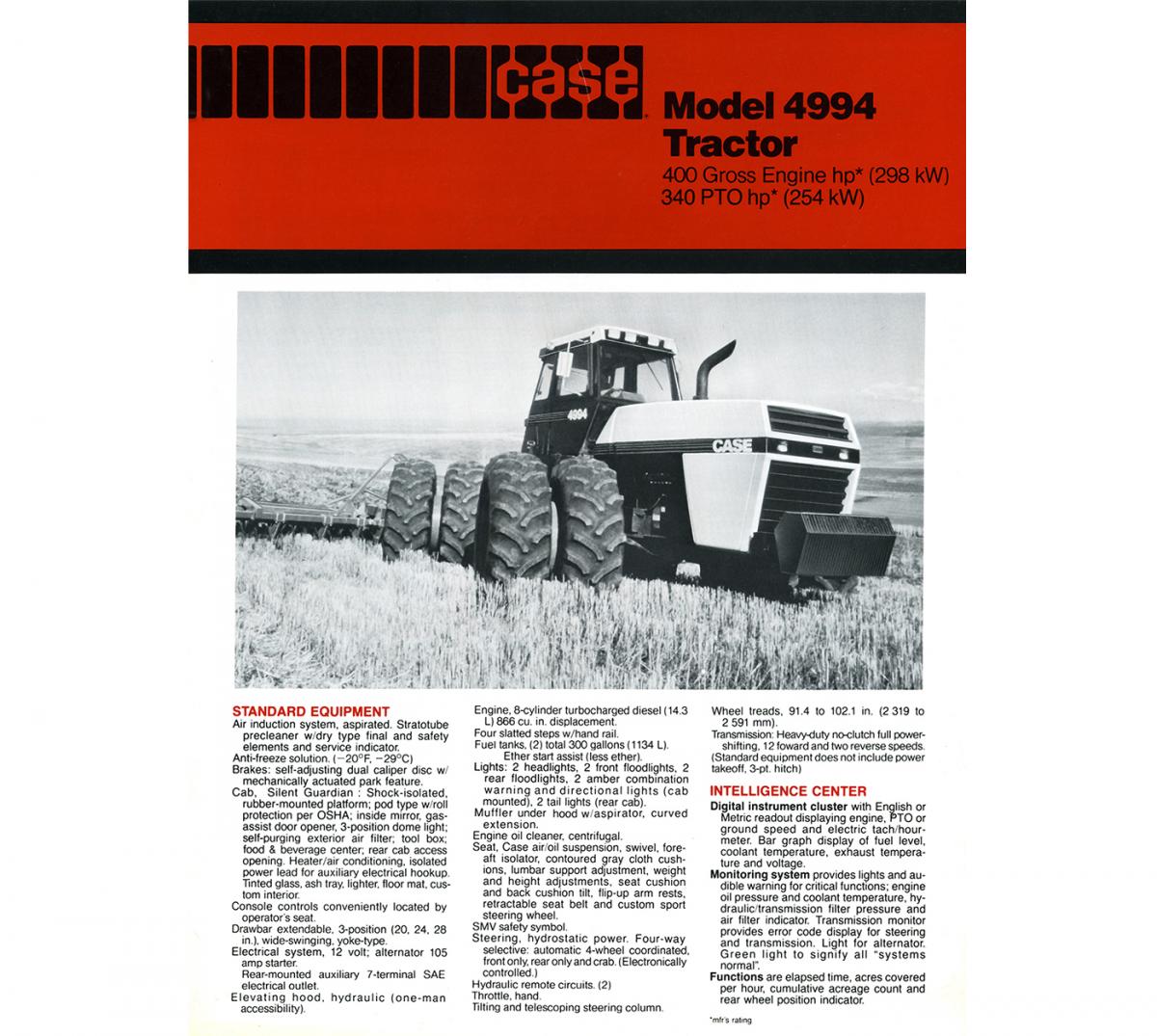 Model Specs
Model Specs
J.I. Case 94 series tractors provided farmers with a reasonably priced, high-horsepower machine. The specifications were ample, if modest compared to the 4WD competition at that time. Case IH
 Case 5090 Prototype
Case 5090 Prototype
As it was being developed in the late 1970s, the tractor that was later to be known as the 4994 was called the 5090. This is a scale model of the prototype at an early stage of development. The exact date of this image is not known, but designer John Mellberg remembers it to be 1977 or 1978. John Mellberg
[Above image caption: This 4994 wears very early Case IH labeling on the hood. Note that “International” is spelled out and in front of CASE. These machines were J.I. Case legacy tractors rebadged after the Case IH merger in 1985. Case IH]
The 94 Series was the final complete evolution of the J. I. Case four-wheel-drive line. It pretty much followed the 90 Series in scope but added a new contender into the mega-tractor market, the 4994. The most noticeable change was a complete turnover to a black-and-white color scheme. This has less to do with cosmetics than it did with new painting regulations from the EPA that added increased expense to the application of certain types and colors of paint, red among them.
The 94 Series went digital when the intelligence center replaced the standard analog instrument panel. The intelligence center offered electronic readouts for fuel, coolant temp, EGT (exhaust gas temperature), and volts, but a multifunction digital readout could switch from rpm, ground speed, wheelslip, acres covered, etc. These features are commonplace today, but in 1984, it was cutting edge. The Silent Guardian cab debuted in the 94 line, claiming to reduce sound levels and it definitely added visibility. The accommodations and control layout were improved to make the cab a nicer place to work those long hours. The differential lock was made electronic with rocker switch activation.
 Case 4494
Case 4494 The 94 Series got some styling changes that include a new black-and-white paint scheme. The 175–PTO horsepower 4494 was no longer the base four-wheel drive, with one model now below it. The 4494 sat on a 102-inch wheelbase and had a maximum ballasted weight of 22,500 pounds. A Cat III hitch was a $6,300 option, and a 1,000-rpm PTO would set you back $3,300. Case IH
 Case 4694
Case 4694 The 4694 was now the middle of a five-tractor lineup and still largely an uprated 4494. The uprate came mainly from the turbo-intercooled 504, which was run at its highest factory rating, 219 PTO horsepower. The black-and-white photo is appropriate in this era because the color scheme had changed to black and white. Case IH
 Case 4894—Top Dog No More
Case 4894—Top Dog No More Still wearing a Power Bulge, the 4894 lost its Top-Dog status in the 94 Series lineup. The powertrain was little changed from the 90 Series. The 300-horsepower DS-11 Scania six had the same bore and stroke of the DS14 V8 and shared some components. The 4894 sat on a 110-inch wheelbase and had a maximum ballasted weight of 28,500 pounds. With dual 20.8-34 tires, it could generate 213.68 drawbar horsepower and 27,627 pounds of pull—almost equal to its ballasted weight. Case IH
For a brief time in the mid-1980s, J. I. Case lived on the top tier with the biggest and most powerful four-wheel-drive tractors on the market. Mounting an 866 cubic-inch Scania V-8 turbo diesel that made 400 horsepower on the flywheel, the 4994 was Nebraska-rated at 344 PTO horsepower and 306 horsepower at the drawbar. The big V-8 was mounted in front of a 12-speed Twin-Disc Power Shift transmission, a very heavy-duty gearbox used by other tractor manufacturers at the time, including Steiger. The 4994’s rigid-frame, four-wheel-steer configuration gave it a few niche markets articulated tractors couldn’t claim, namely areas with hilly ground where the crab steer feature made it invincible.
The 4994 was a good tractor, especially for those who needed its particular skill set, but timing worked against it. It was an expensive tractor introduced in a very down market, but it also had a sales Achilles heel. The V-8 diesel was almost universally reviled in the farming world. This had less to do with the cylinder configuration than the reputation V-8s had acquired via past tractors of other makes. Less-than-robust V-8 engines had been chosen by ill-advised ag engineers in the past and had resulted in early failures for most of them. The V-8s also tended to have a power band higher in the rpm range than inlines and generally delivered less fuel economy.
The Scania did not share these negatives. It was bulletproof and defied some of the V-8 performance and fuel economy norms. No doubt Case’s sales people thought they could market past the V-8 reputation, but that proved only partly true. Few owners had cause to regret their choice, but the V-8 did prevent some sales. A mere 224 were built, all before the formation of Case IH, and they sold slowly. The leftovers were still being sold almost to the time Steiger joined the Case IH family.
The J.I. Case 94 series tractors would be badged as Case IH machines and painted red after the 1985 merger. This series of machines displaced the International Harvester Super 70 Series and Steiger-built four-wheel-drive tractors. For a short time, the 94 series were the largest of the Case IH line of high-horsepower four-wheel-drive tractors. In 1986, Case IH purchased Steiger, and the 94 series was sold off and discontinued.
 Case 4994
Case 4994The Scania V-8-powered 4994 was the highest power tractor J. I. Case had ever built, and it was near the top of tractor horsepower rankings. The tractor sat on a 124.8-inch wheelbase and weighed 26,500 pounds bare. It was rated for a ballasted weight up to 40,000 pounds, with 65 percent of the added weight on the front. Dual 20.8-42 tires were an option, but Erick Jacobson’s is set up for triples of that size. A rear three-point hitch was not available but a 1,000-rpm PTO cost a mere $3,700. Kyla Burnside

 High Power
High Power By any standard, now and especially then, the 866-cubic-inch Scania DS14 V-8 was a powerhouse. Displacing 866 cubic inches from a 5x5.51-inch bore and stroke, the wet-sleeved, direct-injected engine had some very unique design features that included individual heads for each cylinder and a centrifugal oil filter. Torque was 1,165 lb-ft at 1,300 rpm, but it held 996 lb-ft at the 2,100 rpm redline, giving it a long and broad torque band. Case rated flywheel power at 400, but that was the SAE gross rating; SAE net power was 382 horsepower. The DS14 was detuned for tractors, but in European trucks, it made up to 500 and later 565 horsepower. The Australians had a 610-horsepower DS14 before the engine got a major design upgrade in the 1990s. Kyla Burnside
 Model Specs
Model Specs J.I. Case 94 series tractors provided farmers with a reasonably priced, high-horsepower machine. The specifications were ample, if modest compared to the 4WD competition at that time. Case IH
 Case 5090 Prototype
Case 5090 PrototypeAs it was being developed in the late 1970s, the tractor that was later to be known as the 4994 was called the 5090. This is a scale model of the prototype at an early stage of development. The exact date of this image is not known, but designer John Mellberg remembers it to be 1977 or 1978. John Mellberg



